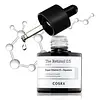What's inside
What's inside
 Key Ingredients
Key Ingredients

 Benefits
Benefits

 Concerns
Concerns

 Ingredients Side-by-side
Ingredients Side-by-side

Water
Skin ConditioningButylene Glycol
HumectantGlycerin
HumectantIsononyl Isononanoate
EmollientC15-19 Alkane
SolventDimethyl Isosorbide
SolventEthylhexyl Stearate
EmollientHydrogenated Polydecene
EmollientPhenoxyethanol
PreservativeSqualane
EmollientAvena Sativa Kernel Extract
AbrasiveSodium Acrylate/Sodium Acryloyldimethyl Taurate Copolymer
Emulsion StabilisingIsohexadecane
EmollientCarbomer
Emulsion StabilisingHydroxypinacolone Retinoate
Skin ConditioningChlorphenesin
AntimicrobialPotassium Hydroxide
BufferingBetaine
HumectantBHT
AntioxidantBisabolol
MaskingDisodium EDTA
Polysorbate 80
EmulsifyingButyrospermum Parkii Butter
Skin ConditioningAloe Barbadensis Leaf Juice Powder
Skin ConditioningSorbitan Oleate
EmulsifyingSodium Hyaluronate
HumectantTocopheryl Acetate
AntioxidantEthylhexylglycerin
Skin ConditioningXanthan Gum
EmulsifyingCaprylyl Glycol
EmollientGlyceryl Caprylate
EmollientLactic Acid/Glycolic Acid Copolymer
Skin ConditioningPhenylpropanol
MaskingPalmitoyl Tetrapeptide-50
Skin ConditioningPolyvinyl Alcohol
Heptapeptide-15 Palmitate
Skin ConditioningHydrolyzed Collagen
Emollient1,2-Hexanediol
Skin ConditioningWater, Butylene Glycol, Glycerin, Isononyl Isononanoate, C15-19 Alkane, Dimethyl Isosorbide, Ethylhexyl Stearate, Hydrogenated Polydecene, Phenoxyethanol, Squalane, Avena Sativa Kernel Extract, Sodium Acrylate/Sodium Acryloyldimethyl Taurate Copolymer, Isohexadecane, Carbomer, Hydroxypinacolone Retinoate, Chlorphenesin, Potassium Hydroxide, Betaine, BHT, Bisabolol, Disodium EDTA, Polysorbate 80, Butyrospermum Parkii Butter, Aloe Barbadensis Leaf Juice Powder, Sorbitan Oleate, Sodium Hyaluronate, Tocopheryl Acetate, Ethylhexylglycerin, Xanthan Gum, Caprylyl Glycol, Glyceryl Caprylate, Lactic Acid/Glycolic Acid Copolymer, Phenylpropanol, Palmitoyl Tetrapeptide-50, Polyvinyl Alcohol, Heptapeptide-15 Palmitate, Hydrolyzed Collagen, 1,2-Hexanediol
 Reviews
Reviews

Ingredients Explained
These ingredients are found in both products.
Ingredients higher up in an ingredient list are typically present in a larger amount.
BHT is a synthetic antioxidant and preservative.
As an antioxidant, it helps your body fight off free-radicals. Free-radicals are molecules that may damage your skin cells.
As a preservative, it is used to stabilize products and prevent them from degrading. Specifically, BHT prevents degradation from oxidation.
The concerns related to BHT come from oral studies; this ingredient is currently allowed for use by both the FDA and EU.
However, it was recently restricted for use in the UK as of April 2024.
Learn more about BHTSqualane is an emollient that helps the skin hold onto moisture. It's an oily liquid that occurs naturally in certain types of fish and plant oils.
Because squalane boosts hydration in the skin, it also comes with plenty of benefits: it is an antioxidant and can help fight free radicals and skin damage. Squalane is also found to have a detoxifying effect when applied.
Squalane comes from squalene, which occurs naturally within the sebum of our skin. It is one of the oils our skin produces to keep itself hydrated. Squalane is the hydrogenated version of squalene and has a longer shelf life.
Research shows that squalane is non-irritating (even at 100% concentration).
In general, it's a fantastic ingredient. It does a great job at hydrating the skin, and it's suitable for those with sensitive skin.
The source of squalane may impact malassezia / fungal acne. This is because olive oil derived squalane can contain impurities such as fatty acids and plant waxes. Sugarcane derived squalane is recommended for anyone with malassezia concerns.
Is squalane vegan?
This depends on the source. Squalane can be derived from both plants and animals. Most squalane used in skincare comes from plants.
Please note: the source of squalane is only known if disclosed by the brand. We recommend reaching out to the brand if you have any questions about their squalane.
Read more about squalene with an "e".
Is squalane an oil?
Squalane is often called an oil, but it’s technically not; it’s a hydrocarbon, meaning it’s only made of carbon and hydrogen, unlike true oils which are triglycerides made of fatty acids and glycerol.
The term “oil-free” isn’t regulated, so companies can define it however they want. Some exclude all oils, while others just avoid mineral oil or comedogenic oils.
While some people avoid oils thinking they cause breakouts, the right kind of oil (or oil-like ingredient like squalane) can actually help balance and hydrate your skin. It’s worth testing out simple oils or squalane to see what works best for your skin.
Learn more about Squalane